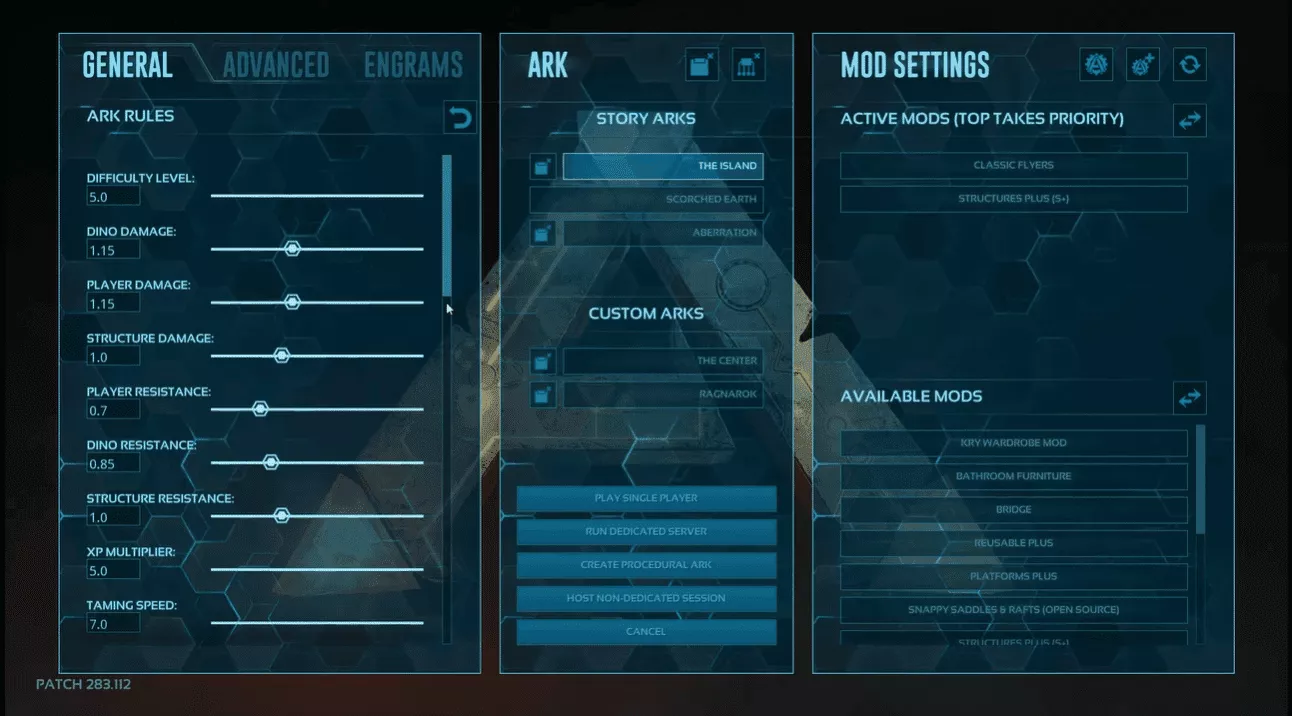Introduction
Welcome to the world of Ark: Survival Evolved! As an avid player, you understand the immense enjoyment that comes from taming dinosaurs, building epic structures, and surviving in a hostile environment. But have you ever wondered how much RAM your Ark server needs to ensure a smooth and seamless gameplay experience? In this article, we will delve into the important considerations for determining the ideal amount of RAM for your Ark server.
RAM, which stands for Random Access Memory, plays a critical role in the performance of your Ark server. It acts as a temporary storage space for the game’s data, allowing for quick and efficient access. With the vast world, player interactions, and complex calculations involved in Ark, having sufficient RAM is crucial to avoid lag, crashes, and other performance issues.
However, determining the right amount of RAM for your server can be a daunting task. It depends on several factors, such as the size of your server, the number of players, the mods and plugins installed, and the overall game complexity. Let’s explore these factors in more detail to gain a better understanding of how much RAM your Ark server will need.
Understanding the Basics of RAM
Before we dive into the specific RAM requirements for an Ark server, let’s take a moment to understand the basics of RAM and its significance in gaming. RAM is a type of computer memory that stores data that is actively being used by the system, ensuring quick and easy access for processing. In the context of gaming, RAM plays a crucial role in storing and accessing game-related information, such as graphics, textures, and game logic.
When you launch Ark: Survival Evolved, the game loads various assets, including the game world, player data, and the AI of dinosaurs and creatures. All of this information needs to be stored in RAM for quick retrieval during gameplay. The more RAM you have, the more data can be stored, resulting in smoother and more efficient gameplay.
Additionally, RAM also affects how quickly your server can respond to player actions. Every time a player interacts with the game, such as moving, attacking, or building, the server needs to process those actions and send the updated information to all connected players. With sufficient RAM, the server can handle these actions smoothly, reducing latency and ensuring a seamless multiplayer experience.
It’s worth noting that RAM is different from storage space, such as hard drives or solid-state drives (SSDs). Storage space refers to where files and data are permanently stored, while RAM is temporary and volatile memory used for active processes. Think of your hard drive as a library where all the game files are stored, and RAM as a desk where the game is actively being played.
Now that we have a clear understanding of RAM’s purpose and importance in gaming, let’s move on to the factors that will help determine the optimal amount of RAM for your Ark server.
Factors to Consider for an Ark Server
When determining the RAM requirements for your Ark server, it’s essential to consider several factors that can impact the performance and overall gameplay experience. Let’s take a look at these factors:
- Server Size: The size of your Ark server plays a significant role in determining the amount of RAM needed. A small server with a limited number of players will require less RAM compared to a medium or large server with a higher player count. The more players and structures in your server, the more RAM will be necessary to handle the increased load.
- Player Count: The number of players accessing your server simultaneously is another crucial factor to consider. Each player adds to the resource requirements of the server. More players means more interactions, more AI calculations, and more data being processed, all of which demand more RAM. Ensure that you have enough RAM to accommodate the expected number of players on your server.
- Mods and Plugins: If your server runs mods or plugins, keep in mind that they can significantly impact RAM usage. Mods and plugins add new features, mechanics, and assets to the game, which require additional memory for storing and processing. The more complex and resource-intensive the mods and plugins are, the more RAM they will consume.
- Game Complexity: Ark: Survival Evolved is a highly complex game with dynamic environments, large maps, and intricate AI systems. The more complex the game mechanics and AI interactions, the more RAM will be required to ensure smooth gameplay. For example, if you have a server with abundant wildlife and active AI behavior, it will demand more RAM compared to a server with fewer creatures and simplified AI.
- Additional Services: Consider any other services or applications running alongside your Ark server. If you are hosting additional services, such as a website or voice chat server, they will also require their share of RAM resources. Be sure to account for these additional services and allocate enough RAM to handle their needs as well.
By carefully considering these factors, you can make an informed decision about the appropriate amount of RAM to allocate to your Ark server. In the next sections, we will discuss the minimum, recommended, and optimal RAM requirements for different server sizes, providing further guidance for your server setup.
Minimum RAM Requirements for a Small Ark Server
If you’re running a small Ark server with a limited number of players and minimal mods/plugins, the minimum RAM requirement would typically be around 4GB. This amount of RAM should be sufficient to handle the basic server operations and provide a decent gameplay experience.
With 4GB of RAM, your server will be able to handle a small number of players, usually around 10-20, without suffering from severe performance issues. However, keep in mind that the more mods or plugins you add to your server, the more RAM it will consume. You may need to allocate additional RAM if you plan on running resource-intensive mods or plugins.
It’s important to note that while 4GB is the minimum requirement, it doesn’t leave much room for future expansion or unexpected spikes in player activity. If you anticipate your server growing or hosting events that will attract more players, it’s advisable to allocate more RAM to ensure stability and prevent performance degradation.
Additionally, it’s crucial to consider other factors such as the complexity of the game world and the number of structures and creatures present. If your server has a large map and a significant number of active entities, you may need to allocate more RAM to prevent lag and ensure smooth gameplay.
Remember that the minimum RAM requirement is just a starting point, and it’s always better to have a buffer in case your server’s needs change. Allocating additional RAM will provide a more responsive and optimized experience for both you and your players.
Now that we have covered the minimum RAM requirements for a small Ark server, let’s move on to the recommended RAM for a medium-sized server in the next section.
Recommended RAM for a Medium-Sized Ark Server
For a medium-sized Ark server with a moderate player count and a few mods/plugins, it is recommended to have at least 8GB of RAM. This increased RAM allocation will provide better performance and accommodate the additional resources required by a larger player base.
With 8GB of RAM, you can comfortably host a server with around 20-50 players, depending on the complexity of the game and the mods/plugins installed. This amount of RAM allows for smoother gameplay, reduced lag, and improved responsiveness, ensuring a more enjoyable experience for everyone involved.
When running a medium-sized server, it’s important to consider the number and complexity of mods and plugins. More resource-intensive mods/plugins may require additional RAM to function optimally. It’s recommended to allocate extra RAM, around 1-2GB, to ensure that these mods/plugins have enough memory to operate smoothly without impacting the overall server performance.
In addition to the player count and mods/plugins, take into account the size of the game world and the number of active entities. A larger map with more structures, creatures, and AI interactions will require additional RAM to handle the increased load. If your medium-sized server has a vast and intricate game world, consider increasing the RAM allocation to ensure optimal performance.
Allocating 8GB of RAM to a medium-sized Ark server strikes a balance between cost-effectiveness and performance. It provides enough resources to accommodate a moderate player base and a reasonable number of mods/plugins. However, keep in mind that if your server experiences unexpected spikes in player activity or if you plan on expanding your server in the future, you may need to allocate more RAM to maintain a smooth gameplay experience.
Now that we have covered the recommended RAM requirements for a medium-sized Ark server, let’s move on to discussing the optimal RAM for a large server in the next section.
Optimal RAM for a Large Ark Server
When it comes to running a large Ark server with a high player count and an extensive selection of mods/plugins, it is recommended to have a minimum of 16GB of RAM. This increased RAM allocation will provide the necessary resources to handle the intensive demands of a large and active player base.
With 16GB of RAM, you can comfortably host a server with 50 or more players, ensuring smoother gameplay and reduced performance issues. This substantial amount of RAM allows for efficient handling of player interactions, AI calculations, and the complex systems within the game.
Large servers often have a wide range of mods/plugins installed to enhance the gameplay experience. These additional mods/plugins require significant resources, including RAM. Allocating more RAM, around 2-4GB, to accommodate the memory requirements of these mods/plugins is highly recommended, as it will ensure optimal performance without impacting the overall stability of the server.
Apart from the player count and mods/plugins, take into account the size of the game world and the number of structures, creatures, and AI interactions present. Large servers with expansive maps, numerous active entities, and dynamic environments demand additional RAM to maintain smooth gameplay. If your server falls into this category, it’s vital to allocate sufficient RAM to handle the increased workload.
Optimizing RAM usage is especially crucial for large servers to ensure that your players have a seamless gaming experience. Consider implementing RAM optimization techniques, such as periodic server restarts, tweaking server settings, and regularly updating mods/plugins to their latest versions. These practices can help free up memory and enhance server performance.
Having at least 16GB of RAM allocated to a large Ark server provides the necessary resources to handle the demands of a substantial player base, numerous mods/plugins, and a complex game environment. However, keep in mind that the needs of your server may evolve over time. Regularly monitor server performance and adjust the RAM allocation as needed to maintain optimal gameplay.
Now that we have covered the optimal RAM requirements for a large Ark server, we will explore some tips for optimizing RAM usage on an Ark server in the next section.
Tips for Optimizing RAM Usage on an Ark Server
Optimizing RAM usage on an Ark server is vital to ensure smooth gameplay, reduce lag, and prevent performance issues. Here are some effective tips to help you optimize the RAM usage on your server:
- Regular Server Restarts: Scheduled server restarts can help free up memory and refresh the server’s resources. Restarting the server periodically, such as once a day or every few days, can prevent memory leaks and alleviate RAM usage.
- Monitor and Adjust Server Settings: Keep an eye on your server’s settings and adjust them to optimize performance. Pay attention to settings related to creature spawns, resource respawn rates, and structure limits. Experiment with different settings to find the balance that works best for your server.
- Remove Unused or Resource-Heavy Mods/Plugins: Evaluate the mods and plugins installed on your server regularly. Remove any that are no longer in use or are particularly resource-intensive. This will help free up memory and improve server performance.
- Disable Unnecessary Features and Functions: Some mods/plugins offer optional features that may not be necessary for your server. Disable any features that are not actively used to conserve memory resources.
- Regularly Update Mods/Plugins: Keep your mods and plugins up-to-date by installing the latest versions. Developers often release updates that include performance optimizations or bug fixes, which can help improve RAM usage on your server.
- Limit Entity and Structure Limits: Configure entity and structure limits within reasonable ranges to prevent overcrowding and excessive RAM usage. Setting specific limits can help maintain a stable and optimized server performance.
- Optimize Mod/Plugin Load Order: The order in which mods/plugins are loaded can impact RAM usage. Organize the load order to minimize conflicts and improve performance. Some mods/plugins may provide recommendations or installation instructions that highlight the optimal load order.
- Consider Using Mod/Plugin Collections: Instead of individually installing multiple mods/plugins, consider using mod/plugin collections provided by the community. These collections are pre-selected and curated sets of mods/plugins that are known to work well together. Using collections can help minimize conflicts and optimize RAM usage.
By following these tips, you can optimize the RAM usage on your Ark server, improving performance and ensuring an enjoyable gaming experience for your players.
Now that we have covered how to optimize RAM usage on an Ark server, let’s summarize the key points discussed in this article.
Conclusion
Allocating the right amount of RAM is crucial for ensuring a smooth and enjoyable Ark server experience. By considering factors such as server size, player count, mods/plugins, game complexity, and additional services, you can determine the optimal RAM requirements for your server.
For a small server, a minimum of 4GB of RAM is recommended, while a medium-sized server should have at least 8GB. Larger servers with a high player count and extensive mods/plugins may require a minimum of 16GB of RAM or more.
To optimize RAM usage on your Ark server, implementing practices such as regular server restarts, monitoring and adjusting server settings, removing unused mods/plugins, and updating them regularly can help to free up memory and improve performance. Additionally, carefully managing entity and structure limits and optimizing the load order of mods/plugins can boost RAM efficiency.
Remember that these RAM recommendations and optimization tips are general guidelines, and the specific requirements of your server may vary. Regularly monitor server performance, player activity, and RAM usage to make informed adjustments as needed.
By adequately allocating and optimizing RAM on your Ark server, you can create an immersive and enjoyable gaming environment for yourself and your players. So, gear up, gather your tribe, and embark on epic adventures in the world of Ark: Survival Evolved!

























